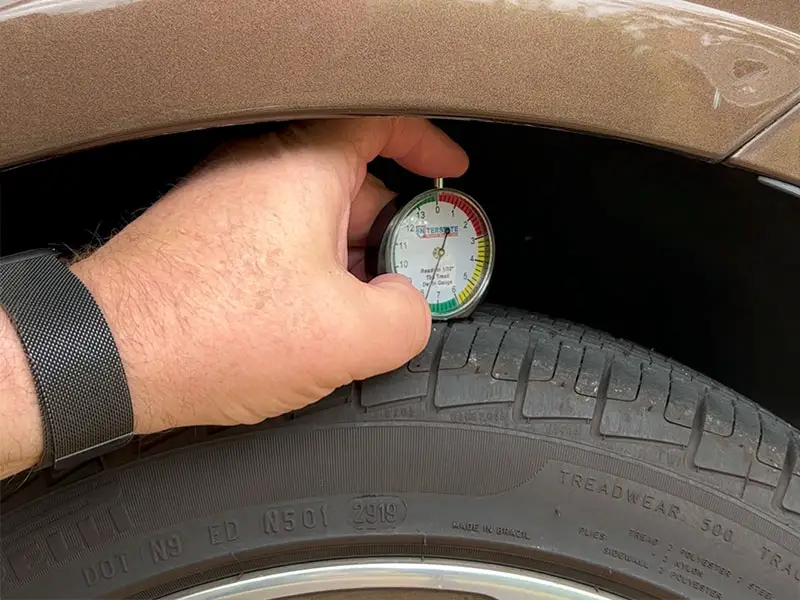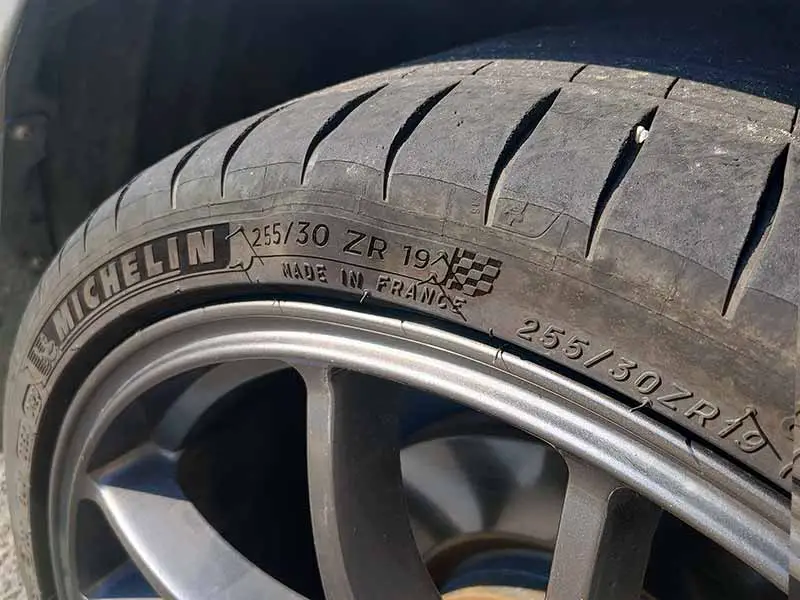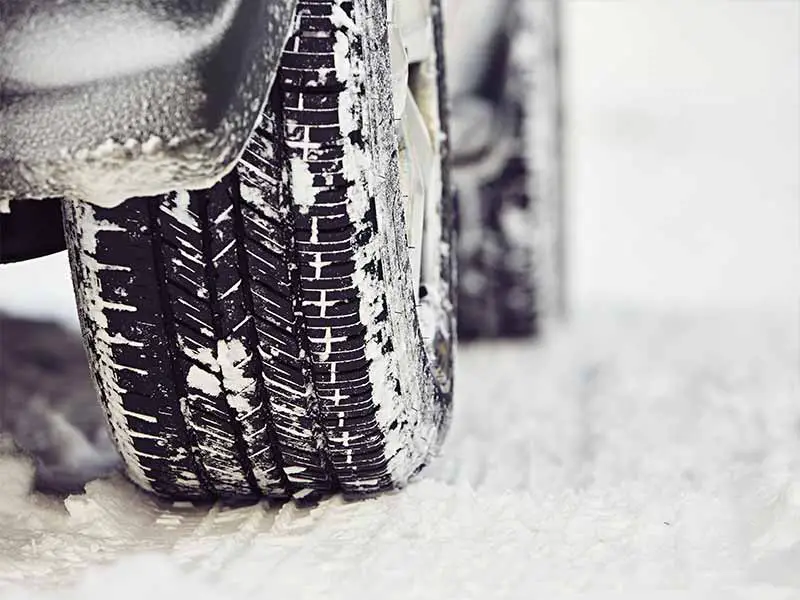If you live in an area that often deals with snow and ice-covered roads, winter tires are a must. Knowing when to replace winter tires is important. Snow and ice make maintaining traction difficult and tread depth is critical to maintaining a better grip in slushy conditions.
Winter Tire Tread Depth
Most states require only 2/32″ of tread depth, even for winter tires.
However, we strongly recommend 5/32″ of tread depth or more for adequate snow traction.
We also recommend 4/32″ for safe driving in wet conditions.
A difference of1/32″ or 2/32″ of your tire’s tread depth can make a big difference in how much grip your tread pattern has on winter roads. Larger grooves in your tread design provide more traction by channeling water, snow, and slush out from underneath and away from your tire’s contact patch.
Let’s take a closer look
How Much Tire Tread Is Safe for Winter?
The overall thickness of your tire tread is going to help your car’s performance, gas mileage, stopping distance, and acceleration. The bigger factors are the pattern and size of your tread, but the depth still matters a lot.
As you drive along, your tires are going to lose a little bit of their overall tire tread depth. Over time, enough depth is lost, and your tires become unsafe to use.
In winter, you have added road hazards like salt, snow, and ice. All three of these hurt your tire’s grip with the road underneath it. As an added precaution, you should plan on having extra tread depth on your tires during the winter to combat the worsened friction of the road.
Whether you have all-season tires or winter tires, you should consider changing them if they have less than 5/32” tread. We suggest checking the tread near the middle of Fall, so you have enough time to prepare for winter.
Even if your tires perform okay with 2/32” of tread in the summertime, the winter is a lot more dangerous, so it’s wise to swap them before the first snowfall or round of ice.
What Is the Minimum Tread Depth for Snow?
When it comes to driving on snow, things get more dangerous. As a result, you’ll need deeper tread depths to safely drive.
While most states don’t have a legal minimum tread depth for winter tires that is different than the depth for all-season or summer tires, we recommend maintaining 5/32″ or more of tread depth.
There are three major issues with driving on snow:
- As a material, snow is very low-friction (just like water or ice). This means that your tires won’t have as much grip. This leads to losing control, spinning out, and taking longer to come to a stop.
- Snow will get caked into your tire treads and can form a layer around your tires. Again, this isn’t a good thing since it lowers how much your tires can grip the road while you drive.
- Snow can hide icy patches. Ice has almost no friction at all, and it’s easily the most dangerous road condition. Since snow is a result of freezing rain, it’s really cold, and it layers on top of the road, it can easily hide ice underneath it.
With all of these factors in mind, it seems logical that you should have even thicker treads for drives through the snow. We suggest keeping at least 4/32” of tread if you want to drive through the snow. The safest option is to avoid driving whenever it’s snowy or icy outside, but we understand there are some unavoidable scenarios that come up.

At What Tread Depth Should Snow Tires Be Replaced?
You should replace your snow tires if you have 5/32” of tread or less. You’ll notice that this is much thicker than the requirement for standard tires, which says that standard tires should be replaced when they have 2/32” of tread.
Snow tires or winter tires are designed specifically for driving through snowy roads in the wintertime. You’ll see them a lot in the cold Northeast of America.
Since tread depth plays a large part in stopping distance, performance, and safety on snow-covered roads, you’ll want to make sure your snow tires have plenty of tread depth remaining.
The reason behind that decision is that drivers expect their winter tires to give them even more grip through poor road conditions. If you drive winter tires that only have 2/32” of tread, you’ll be much more likely to lose control on a snowy road. The extra bit of tire tread makes a huge difference.
How Long Do Winter Tires Last?
In theory, winter tires will last just as long as standard tires, under the same conditions. In other words, if you’re always driving on winter tires, they’ll last until they’ve reached 6 years or about 40,000 miles.
It’s possible that you won’t put 40,000 miles on a set of snow tires that you only use for part of the year. You’re probably only using them for 4 to 5 months of the year, and they’re otherwise sitting in storage. For that reason, we suggest that you count the age of the tires, not the total mileage. Tires will start to dry rot and degrade after 6 years.
It’s also important to store your tires correctly. If you just throw them in your yard between uses, they’ll rot much faster and their life expectancy will go down. Ideally, they should be bagged, stood up, and stored out of the sunlight.
You should also check the remaining tread depth before putting snow tires back on your car or truck. Once your tire wear reaches 4/32″ you should replace them. If they’ve worn down to the legal limit which is 2/32″ in most states, you must replace your tires.
Tire Life Calculator
How Deep Is the Tread on New Winter Tires?
New winter tires typically have the same thickness of tread that standard tires have. If the tread gets too thick, then the tire might not fit in the wheel well or it won’t fit on the properly-sized wheels.
New winter tires tend to have around 11/32” of overall tread depth. For reference, they don’t need to be replaced until they hit 4/32” to 5/32”, so there’s a huge amount of usable tread there.
How To Tell If Winter Tires Are Still Good
There are a few conditions that might cause you to replace your winter tires.
- Check their age. Winter tires need to be replaced 6 years after the tire was manufactured. That’s when the rubber naturally degrades and your tires become unsafe. This is important to understand for tires that aren’t used year-round. Check your tire wall for text that says “DOT” and read the four-digit code at the end of that text. The first two digits are the week number of fabrication, and the last two digits are the year number. 3122 means it was made on the 31st week of the 2022nd year.
- Measure the tread depth. As long as your treads are more than 4/32” thick, you should be okay. If you expect to drive through the snow, then that number bumps up to 5/32” thick. To measure the exact tread depth of your new winter tires, you should use a tire tread depth gauge. The penny test isn’t a good way to measure tread depths on a winter tire since a snow tire requires deeper tread depths for adequate snow traction than all-season tires do for good traction on wet roads.

- Look for tire damage. Any amount of tire damage can lead to a blowout or uneven wearing. Either of these conditions is very unsafe, so you should replace your tires immediately. If you see a puncture, sidewall bulging, or any bubbling or cracking, then take your tires to an expert for an immediate replacement.

As long as all three of these conditions are met, you should be okay to keep driving your winter tires. If you’re not sure how many miles you drove on these specific tires, that’s okay. The tread depth will tell you everything you need to know. When the treads are too shallow, it’s a result of driving a lot of miles and having the rubber wear out through use.
What Is the Longest Lasting Winter Tire?
Winter tires provide good performance by using softer rubber compounds. The soft rubber remains flexible to provide better traction in cold temperatures and icy conditions. Due to this fact, however, snow tires will not achieve the same amount of mileage as traditional all-season tires.
There are a lot of winter tires that are designed to do different things, but which option is the longest-lasting? According to our experts, it’s the Michelin X-Ice Snow. This option lasted a lot longer while still safely providing the ability to drive through snowy and salted roads.
The Michelin X-Ice Snow tires have a mileage warranty of 40,000 miles and are backed up by very high marks from customers for their treadwear.
Resources
Below are some links you may find helpful when learning about tires
- Make sure your tires have enough tread for a snowy winter – Consumer Reports
- How to store tires between seasons: A simple 4 step guide – Firestone
Final Thoughts
All tires work best when they have more tread depth. This is especially true for winter tires and all-season tires that are used on snow and ice-covered roads.
While the legal minimum tread depth in most states allows 2/32″ of tread wear, this is risky when the road surface becomes wet, on packed snow, or in icy conditions. Even all-wheel drive or four-wheel drive vehicles will struggle to maintain traction if the tires aren’t up to the task.
We strongly recommend purchasing new tires for winter months when you have reached 5/32″ of remaining tread depth. There’s a big difference in performance for every 1/32″ your tread blocks wear beyond this point.
Good luck and happy motoring.




